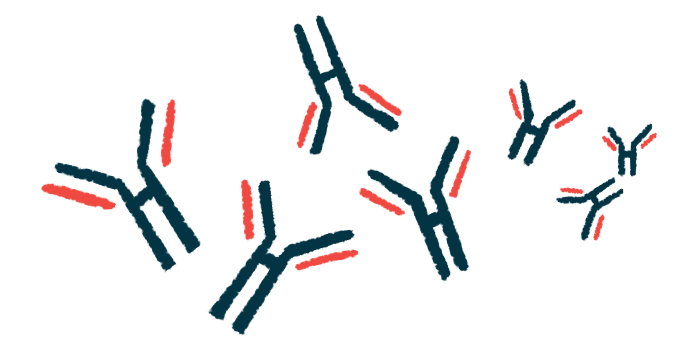EGPA symptoms differ by patients’ antibody type, study suggests
Lungs seen as highly affected in those with ANCAs against MPO, less so in others

Different types of disease-driving antibodies tend to associate with different symptoms of eosinophilic granulomatosis with polyangiitis (EGPA), the rarest form of ANCA-associated vasculitis.
That’s according to the study “Spectrum of ANCA-specificities in eosinophilic granulomatosis with polyangiitis. A retrospective multicenter study,” published in Clinical and Experimental Rheumatology.
ANCA-associated vasculitis is caused by the abnormal production of anti-neutrophil cytoplasmic autoantibodies, or ANCAs, from which the disease gets its name. These self-reactive antibodies mistakenly stick to specific proteins in certain immune cells, triggering inflammation and damage to small blood vessels that drive disease symptoms.
EPGA seen to have ANCAs with various targets ‘other than MPO’
The most common targets of ANCAs are the proteinase 3 (PR3) and myeloperoxidase (MPO) enzymes. In the disease’s rarest type, EGPA, only about 30% of patients are positive for ANCAs, mostly targeting MPO.
“The remainder is commonly referred to as ‘ANCA negative’ with reference to their MPO-ANCA status,” the researchers wrote, adding that there seems to be different genetic and clinical profiles between EGPA patients with and without anti-MPO ANCAs.
However, there’s little information on the presence of other types of ANCAs in this patient population, and whether these antibodies are linked to different disease manifestations remains unclear.
A team of scientists in Germany retrospectively analyzed demographic, clinical, and antibody data from 73 EGPA patients treated at three centers in that country between 2015 and 2020.
Patients were evenly divided by sex — 38 males and 38 females — and their median age was 58.
Most of the patients (54.8%) were in remission following disease treatment with immunosuppressive therapies, while 22 (30.1%) were newly diagnosed with EGPA, and 11 were experiencing a relapse (15.1%).
A total of eight (11%) patients tested positive for ANCAs against MPO. This rate is on the low end of the range that has been previously reported in EGPA (10% to 70%), the researchers noted.
All of the MPO-positive patients had lung involvement as an aspect of their disease, and three-quarters of them had disease-related damage to the nerves outside the brain and spinal cord, known as the peripheral nervous system.
Consistent with previous reports, these symptoms were significantly less common among patients who did not have anti-MPO ANCAs (89.2% for lung involvement and 47.7% for that affecting peripheral nervous system).
However, MPO-negative patients had significantly higher rates of disease involvement affecting the heart (44.6% vs. 12.5%), brain/spinal cord (13.8% vs. 0%), and the ears, nose, and throat (87.7% vs. 75%).
ANCAs targeting PR3 were found in only two patients (2.7%), so the researchers could not perform meaningful statistical analyses to compare rates of symptom manifestations.
Other types of ANCAs, including those targeting the pentraxin 3 (PTX3) protein, were detected in five (6.8%) of the patients, including one positive for ANCAs against both PTX3 and MPO. This rate was lower than the that previously reported for this patient population (40%), the team noted.
In all PTX3-positive patients — four of whom had active disease — the disease affected the lungs and the ears, nose, and/or throat. This group also showed significantly higher rates of peripheral nervous system (80% vs. 48.5%) and gastrointestinal involvement (60% vs. 17.6%) than did patients without such antibodies.
In turn, significantly lower rates of kidney (0% vs. 16.2%) and brain/spinal cord involvement (0% vs. 13.2%) were detected in patients with anti-PTX3 ANCAs.
Two patients (2.7%) were found to harbor ANCAs targeting a protein called olfactomedin 4 (OLM4). This is the first time that ANCAs against OLM4 have been documented in people with EGPA, according to the scientists.
One of these patients had new-onset EGPA, while the other had relapsing disease. Both had multiorgan involvement.
The “detection of ANCA with various [targets] other than MPO discloses a higher total prevalence of ANCA in EGPA,” the researchers wrote.
“Clinical manifestations [symptoms] differ between EGPA patients with distinct ANCA antigen-specificities and ANCA negative patients,” the team wrote.
As such, “ANCA with [target-specificities] other than MPO such as PTX3 and OLM4 may emerge as potential biomarkers defining further EGPA subsets,” they added.
Given the limited number of patients available for this study, the researchers highlighted a need for further research to better understand how antibody type affects disease manifestations in EGPA, which could be important in guiding treatment decisions.







